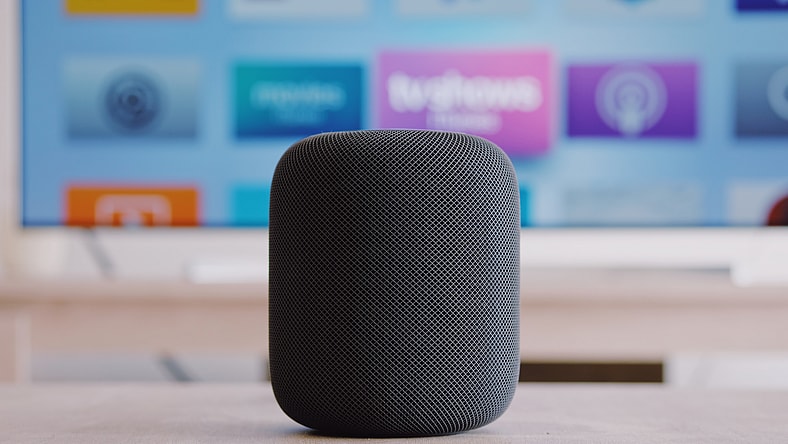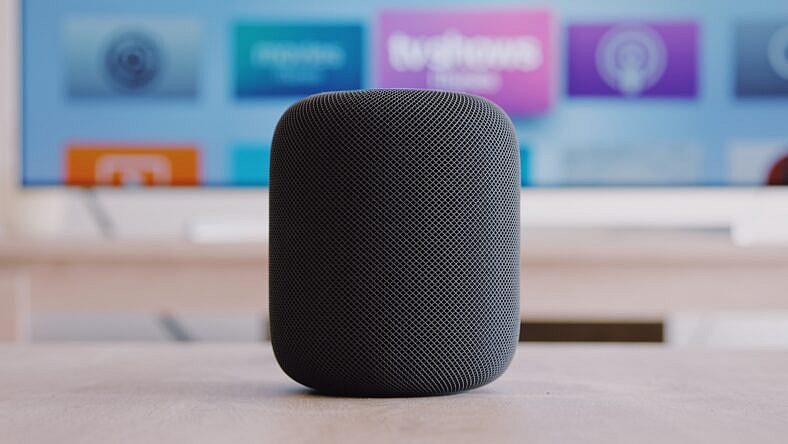
In February, Apple released their latest HomePod, the third model in this line, at a reasonable price of $299. This squat little device is not only a speaker with intelligent audio tuning capabilities, but also a fully integrated smart home hub, granting you access to your other smart devices, all from the HomePod itself.
This model is a direct follow-up to the discontinued original HomePod from 2018, and with most of the same functions and design features, this device may sound familiar. In the interim, the smaller HomePod Mini was released in 2020, which shaved down the dimensions and price of the full-size HomePod, as well as some of the internal specs, but still remains a useful device in its pared down state. We’ll be focusing our eyes on the newest model of HomePod, but I encourage you to take a peek at the HomePod Mini on your own, as a viable, budget-friendly option.
Apple HomePod

In our Apple HomePod 2023 review, we'll explore its features, audio quality, and functionality beyond a speaker as a smart home hub.
Product Price: $299
Product In-Stock: InStock
4
Pros
- Good hardware
- Intelligent tuning technology
- Home hub functions
- Sleek look
Cons
- Doesn't include Spotify or Amazon Music
Apple HomePod Physical Design

Let’s first take a look at the physical design of the HomePod. The body shape is a flat-topped cylindrical pill, which some have compared to a marshmallow. That wasn’t the first thing to enter my mind, but I find it pleasingly accurate. With the only two color options being White or Midnight, you can choose whether you like your techie marshmallow to look fresh or fully roasted. Or, if you can’t decide, get one of each for a two-toned stereo display.
Most of the body is encased in an acoustically transparent fabric mesh, which doesn’t inhibit the sound waves from flowing freely. There’s two volume control buttons placed within the circular LED touchscreen, inset on the top of the speaker. The buttons are self-explanatory, and the glowing touchscreen is where you’ll interface with the HomePod, controlling your music, your other devices, and Siri.
Finally, there’s a detachable cord for easy repositioning around furniture and through cord holes, which is an improvement from the previous model. At 6.6 inches tall, and 5.6 inches wide, the HomePod is a good size to sit attractively on any surface, both eye-catching and unobtrusive at the same time. It also has a nice heft to it, without being too weighty, coming in at a respectable 5.16 pounds.
Check Out: Why Is the Ring Camera System So Popular?
Powerful Audio in a Small Package

Delving deeper into our Apple HomePod 2023 review, let’s discover the high-fidelity audio technology inside the attractive casing. Five beamforming tweeters, each paired with a powerful neodymium magnet for better performance, are arrayed around a 4-inch custom-engineered, high-excursion woofer. Apple boasts that this tech will deliver rich bass tones, clear high notes, and a natural-sounding mid-range. There’s a dedicated low-frequency microphone, for automatically correcting the bass for perfect EQ calibration, and four additional microphones to capture sound reflections off of surfaces, supporting the room-sensing algorithm.
Rounding out the hardware, the Apple Silicon processor powers computational audio software, to fit the sound to the environment by sensing the placement of the HomePod in relationship to people, furniture, and partitions within the room, and adjusting tuning and directional output in real-time. This helps create an ideal listening experience no matter where you or the HomePod are within the space. You can pair two HomePods in one room for a stereo set-up, separating left and right channels, or playing both in harmony for a fuller soundscape. You’ll get the effect of a Soundbar with a smaller countertop footprint.
You can also place multiple HomePods around the house to spread the music to every room. Speakers in different rooms can all sync to play the same song, or be controlled individually for a different soundtrack in each space.
Access (Most of) Your Music

Unsurprisingly, HomePod can play music from Apple Music, iTunes, and your iCloud music library, as well as select third-party services, like iHeartRadio, TuneIn, and Audacy. There are some glaring omissions, like Spotify and Amazon Music, but Apple does enjoy their proprietary ecosystem, and it’s lucky that any non-Apple services are directly accessible. To be fair, you can put in a little extra effort and bridge to those other services through AirPlay via your iPhone, but it does require that additional step.
Good news for HomePod buyers without an Apple Music subscription. You’ll get 6-months free with your purchase, so even if you somehow don’t have a music library of your own on any of those compatible services, Apple has you covered for half a year.
You can handoff whatever you’re listening to on your iPhone to the speaker, or take what was playing on the speaker away with you on your phone seamlessly. Multiple users can access and connect their various music libraries with the same HomePod, not just the device’s owner. Utilizing its Ultra Wideband chip, anyone can bring their iPhone within close proximity to the HomePod to control what’s playing, or get personalized recommendations based on their listening preferences. Additionally, up to six people can be granted voice control access, so all members of the family can easily launch their own playlists.
Also Read: 10 Best Bass Earbuds for Every Budget in 2023
Not Just a Speaker

If this was the end of my Apple HomePod 2023 review, I’d say it was already a decent speaker, but this device goes beyond, with its smart home hub functionality. Using the built-in temperature and humidity sensors, you can set the HomePod to automatically recognize pre-set environmental parameters, and adjust your climate control devices accordingly.
Due to those four microphones mentioned in the audio hardware section, not only can Siri hear your “Hey Siri” and subsequent commands from across a large room, they can also recognize and react to the sound of smoke or carbon monoxide alarms, and send a notification to a home owner’s phone. The inclusion of Matter, the gold-standard protocol for smart home interoperability, means that any device using the Matter protocol can interface with all others. This is true regardless of if they’re made by Apple, Samsung, Amazon, or any of the other 170 companies currently using this standard. Your HomePod will be able to connect to all of your other smart home devices, and with Siri onboard, you’ll be able to use voice activation to control them.
You’ll know Siri is listening when the touchscreen is glowing. You can ask Siri to turn on your lights, adjust the thermostat, lock your front door, close your blinds, etc. You can customize what Siri can control through your HomePod by using the Home app, the main access portal to settings and functions of both the HomePod and HomePod Mini. You can even locate misplaced accessories through the HomePod and Home app.
Your Data Is Not Their Data

We live in a world where we’ve come to accept a certain level of data sharing with corporations. We loudly proclaim the importance of privacy, then blindly agree to ToS that allow our data and identities to be tracked when we use apps or devices. Apple takes great care to protect us from unwittingly sharing our data.
There are several measures inside the HomePod to safeguard our privacy, while giving us some added safety features. All smart home and Siri communications are end-to-end encrypted, meaning they can’t even be read by Apple, and our devices are controlled through other local devices, never from the cloud. Siri does not save voice requests, and only listens for the specific “Hey Siri” trigger phrase. Your requests aren’t even associated with your personal Apple ID, but rather a randomized identifier, for an extra layer of privacy.
Check Out: 5 Cheap Soundbars That Will Improve Your TV’s Sound For $100 Or Less
Apple Goes Green

Corporations aren’t always associated with green initiatives, but Apple has made a pledge to go totally carbon neutral by 2030. They have already been successful within global corporate operations by reducing their manufacturing and supply chain emissions. The HomePod fits into this goal in several aspects. Many components are made from 100 percent recycled materials, including rare earth elements in speaker magnets, tin solder and gold plating in circuit boards. The mesh fabric that surrounds the product is made out of 30 percent recycled plastic.
The packaging takes up the cause as well with 100 percent of wood fibers originating from responsibly managed forests, and containing no outer plastic wrap. In addition to materials going green, the HomePod is also energy efficient, with an ENERGY STAR® certification and all assembly sites are being transitioned to 100 percent renewable energy for production.
Welcome a HomePod Home in 2023

As you can see, the Apple HomePod is not only an attractive, quality speaker, but also a helpful smart home hub, with lots of connected functionality. Read more about everything the HomePod has to offer, then hop over to the store to bring one home for $299. If you can’t commit to a full-size model, check out the HomePod Mini, a viable option for the budget-conscious, with many of the same features and functionality as its larger cousin, for just $99. If you aren’t convinced by this review, or just want some other options to browse, here are a few of Nerdable’s 2022 picks for HomePod alternatives.


